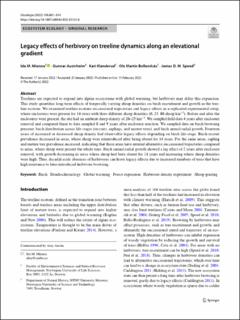| dc.contributor.author | Mienna, Ida Marielle | |
| dc.contributor.author | Austrheim, Gunnar | |
| dc.contributor.author | Klanderud, Kari | |
| dc.contributor.author | Bollandsås, Ole Martin | |
| dc.contributor.author | Speed, James David Mervyn | |
| dc.date.accessioned | 2023-11-24T13:46:04Z | |
| dc.date.available | 2023-11-24T13:46:04Z | |
| dc.date.created | 2022-04-29T12:25:25Z | |
| dc.date.issued | 2022 | |
| dc.identifier.citation | Oecologia. 2022, 198 801-814. | en_US |
| dc.identifier.issn | 0029-8549 | |
| dc.identifier.uri | https://hdl.handle.net/11250/3104584 | |
| dc.description.abstract | Treelines are expected to expand into alpine ecosystems with global warming, but herbivory may delay this expansion. This study quantifies long-term effects of temporally varying sheep densities on birch recruitment and growth in the treeline ecotone. We examined treeline ecotone successional trajectories and legacy effects in a replicated experimental setup, where enclosures were present for 14 years with three different sheep densities (0, 25, 80 sheep km−2). Before and after the enclosures were present, the site had an ambient sheep density of 20–25 km−2. We sampled field data 4 years after enclosure removal and compared these to data sampled 8 and 9 years after enclosure erection. We sampled data on birch browsing pressure, birch distribution across life-stages (recruits, saplings, and mature trees), and birch annual radial growth. Fourteen years of increased or decreased sheep density had observable legacy effects depending on birch life-stage. Birch recruit prevalence decreased in areas, where sheep were reintroduced after being absent for 14 years. For the same areas, sapling and mature tree prevalence increased, indicating that these areas have entered alternative successional trajectories compared to areas, where sheep were present the whole time. Birch annual radial growth showed a lag effect of 2 years after enclosure removal, with growth decreasing in areas where sheep had been absent for 14 years and increasing where sheep densities were high. Thus, decadal-scale absences of herbivores can leave legacy effects due to increased numbers of trees that have high resistance to later-introduced herbivore browsing. | en_US |
| dc.language.iso | eng | en_US |
| dc.publisher | Springer | en_US |
| dc.rights | Navngivelse 4.0 Internasjonal | * |
| dc.rights.uri | http://creativecommons.org/licenses/by/4.0/deed.no | * |
| dc.title | Legacy effects of herbivory on treeline dynamics along an elevational gradient | en_US |
| dc.title.alternative | Legacy effects of herbivory on treeline dynamics along an elevational gradient | en_US |
| dc.type | Peer reviewed | en_US |
| dc.type | Journal article | en_US |
| dc.description.version | publishedVersion | en_US |
| dc.source.pagenumber | 801-814 | en_US |
| dc.source.volume | 198 | en_US |
| dc.source.journal | Oecologia | en_US |
| dc.identifier.doi | 10.1007/s00442-022-05125-8 | |
| dc.identifier.cristin | 2020098 | |
| cristin.ispublished | true | |
| cristin.fulltext | original | |
| cristin.qualitycode | 2 | |

